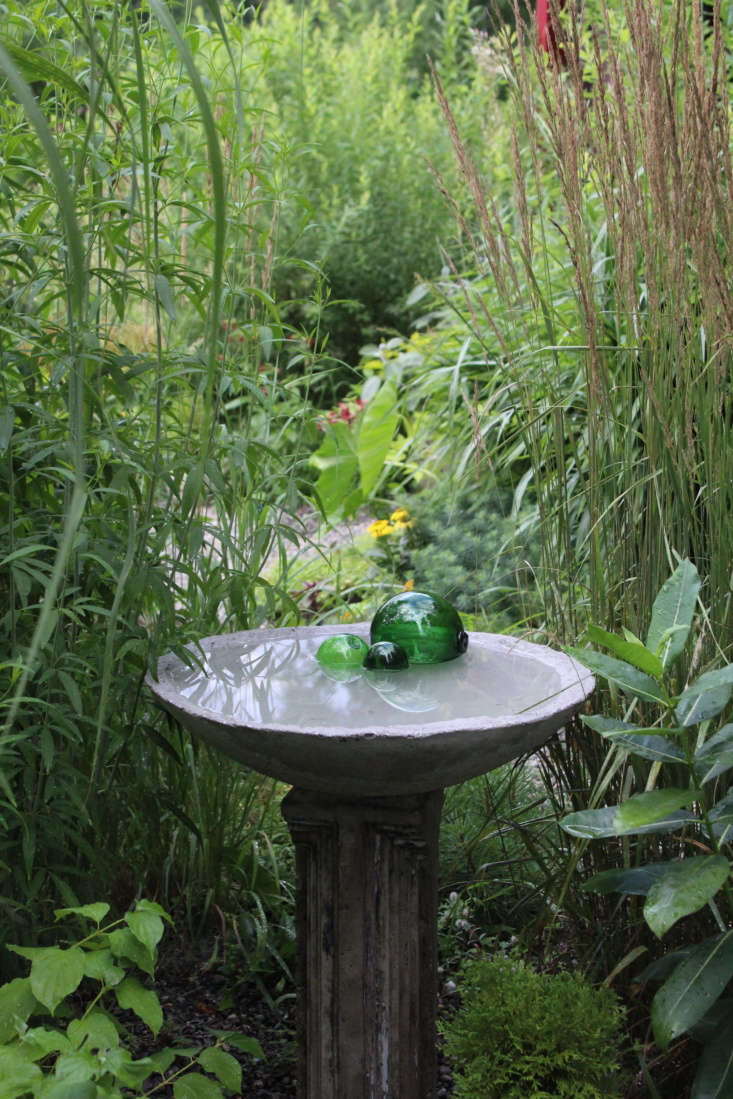Enter a garden with a well done water feature and, instantly, a sense of wellbeing washes over you. It could be because of the soothing sound; the cooling, reflective qualities; or the sight of fish frolicking among aquatic plants. Whatever the reason, the presence of water in a garden creates a relaxing environment—which explains why so many people add a water feature to their wish list when designing or refreshing a garden.
However, like most things in this world, there are pros and cons to water features. Knowing what lies ahead—the good and bad—can help you decide. So, before you build or buy a water feature, let’s break down the basics so that you can make an educated choice on whether this watery element is the right addition to your garden.
N.B.: Featured photograph by Jackie McKeon, from Garden Visit: Classic English Garden Style at Hollister House in Connecticut.

What are the different types of water features?
Many types of water features exist but here are some main ones to consider:
1. Bird baths.
2. Drilled rocks—made with materials such as slate, limestone, or sandstone—that have a hole on top through which water bubbles up.
3. Container ponds, often featuring barrels, metal containers, or large plastic vessels.

4. Pondless types that usually incorporate a large vessel or a drilled rock. The water flows up through the container or rock and then trickles down through rocks then recirculates back up. This style is perfect for families with dogs and/or young children as there is no risk of drowning and there is no water for dogs to go renegade swimming in.
5. Rills, which are basically narrow and shallow canals that stream water in a straight line. This style is perfect for classic or contemporary gardens.

6. Water blades, which are a modern feature where a blade allows a curtain of water to continuously flow over and into a small basin. You can either buy a pre-made one with a small blade already built in and has a basin, or you can custom build this style.
7. Wall fountains, a classic water feature for small patios that come in kits that are easy to install.
8. Streams/ponds, perfect for a woodland or Asian garden. Some gardens just have a pond, some a waterfall and a pond, and larger properties have a stream that flows into a pond.
What are the pros of water features?

- It can be one of a kind. You can totally think outside the box when it comes to water features and create a watery experience that suits your taste, style, and garden. You can hire a contractor or DIY a water feature that no one else has. The options for materials, size, and shape are endless. A quick Google search yields hours of inspiration.
- It can be instant satisfaction when you buy a pre-made water feature that comes with a pump, filter, and a power cord.
- It can be simple. I wanted an element of water in my garden but after knowing the cons of a larger, more complex feature, I settled on a simple bird bath. This serves two purposes: it helps my local feathered friends and adds a pleasant, subtle feel.

- It can add beauty. Well-designed water features are pleasant and engaging. People also tend to linger longer in gardens with water features.
- It can be a soothing auditory experience.The sound of trickling or rushing water is relaxing; plus the white noise is especially helpful at drowning out freeway and other road noises.
- It can provide a focal point. A sure way to add drama and lure the eye (and ears) is to add a water feature. Properly placed, a water feature can take center stage or complement a garden area. It can even make a garden look bigger by being “nature’s mirror.”
- It can attract wildlife. Water naturally invites and supports all sorts of visitors, from tiny insects to bathing birds to visiting frogs and turtles.
What are the cons of water features?

- It can attract wildlife. Some people might not enjoy an influx of wildlife. Also, stagnant water can attract mosquitos, so prepare to either add mosquito fish, a safe additive, or use a pump that circulates the water.
- It may be too loud. Before buying a pre-made fountain, make sure to listen to the sound it creates. Sometimes, the streaming water may sound more like a leaky toilet. Or it may rush too loudly and disrupt casual conversations.
- It can be costly. Water features can be pricey to buy or build, especially larger custom ones requiring excavation, plumbing, electrical, and pallets of rock material.

- It can be hard to maintain. The biggest drawback of a water feature is the upkeep, especially if it’s situated under messy trees, where leaves and petals and seeds can gunk up the water and clog the filter and pump. (Pro tip: Avoid building a water feature or placing a pre-made one under pines or oaks. Trust me on this one.) Your maintenance chores will include:
- Regularly removing excess debris and dead leaves. Some water features need to be regularly drained, scrubbed to remove excess dirt and algae, and then refilled.
- Monitoring water levels. Losing too much water to evaporation will stress out a pump—and replacing filters and burnt out pumps is expensive and a total pain.
- Be on the lookout for leaks. Even concrete-based water features can spontaneously start leaking.
- Care for the fish. If you add fish to your water feature, then care for them needs to be factored in.
See also:
- Everything You Need to Know About Fountains
- 10 Easy Pieces: Bird Watering Holes
- Ultimate Luxury: 10 Favorite Fountains and Garden Water Features












Have a Question or Comment About This Post?
Join the conversation (0)